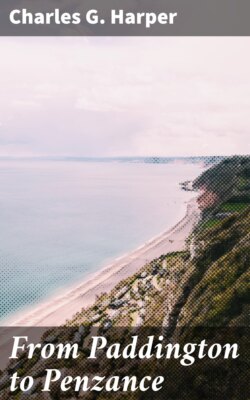Читать книгу From Paddington to Penzance - Charles G. Harper - Страница 10
На сайте Литреса книга снята с продажи.
VIII.
ОглавлениеTable of Contents
And so we came into Hampshire. A weary county this, for those who know not where to seek its beauties—a county of flint-bestrewn roads, a county, too, of unconscionable distances and sad, lonely, rolling downs. Hampshire, indeed, seems ever attuned to memories in a minor key. It is, possibly, but a matter of individual temperament, but so it seems that this county of pine woods and bleak hills—bare, save for some crowning clump of eerie trees, whose branches continually whisper in sobbing breezes—shall always restrain your boisterous spirits, however bright the day, with a sense of foreboding. How much more, then, shall you be impressed of eventide, should you be still abroad, to see how weirdly the sun goes down behind those hill-tops, which then grow black beside his dying glory, while the water-meadows below grow blurred and indistinct, as the night mists rise in ghostly swirls. These thoughts can never find adequate expression, charged as they are with a latent superstition which, despite the lapse of centuries, lingers yet, perhaps unreasonably.
Such are the emotions conjured up by Nature in Hampshire. You may test their force readily at sundown, outside Winchester, when the huge mass of St. Catherine’s Hill looms awfully above the water-meadows of the Itchen, etched in deepest black upon the radiant evening sky. Gazing thus, and presently possessed of a fine thrill of superstitious dread, or artistic admiration—what you will—you may turn and encounter, full to the gaze, the twinkling lamps of the City—prosaic indeed.
INSCRIPTION: SHERBORNE SAINT JOHN.
But we anticipate, as the artless novelist of another generation was used to remark, with a painful frequency. Before Winchester, Basingstoke. This morning, we took an early walk to Sherborne St. John, an outlying village, now suburban to Basingstoke, a village, as it proved, uninteresting. The church, as was to be expected at 8 a.m., was locked: our only reminiscence of the place, then, is this problematic inscription from the doorway. Returning, we made a nearer acquaintance with that ruined chapel—the chapel of the Holy Ghost—familiar to all travellers by the South-Western Railway, standing as it does beside the Station. Here was established the lay Fraternity of the Holy Ghost, founded at that late period when Gothic architecture began to feel the influence of the Renaissance. The mixed details are very interesting, though, unfortunately, much mutilated. Gilbert White, the historian of Selborne, says he was, when a schoolboy, “eye-witness, perhaps a party concerned”—observe the grace of later years that made him ashamed of the occasion, and willing to doubt his participance—“in the undermining a vast portion of that fine old ruin at the north end of Basingstoke town.” The motive for this destruction (he says) does not appear, save that boys love to destroy what men venerate and admire; the more danger the more honour, and the notion of doing some mischief gave a zest to the enterprise.
“It looked so like a sin it pleased the more.”
The Chapel stands within the cemetery known locally as the Liten. Within its walls are two mutilated effigies on altar-tombs, the sole remains of a building long preceding the present ruin, hacked and carven with many penknives.
Holy Ghost Chapel, Basingstoke
Modern Basingstoke—“name of hidden and subtle meaning,” as Mr. Gilbert says in “Ruddigore”—is prosperous, cheerful with the ruddy mellowness of red-brick, and loyal with a lofty Jubilee belfry-tower to its Town Hall; and that is all the spirit moves me to set down here of the town.
